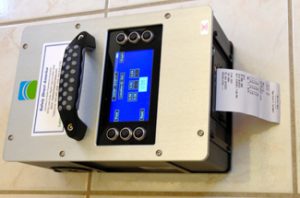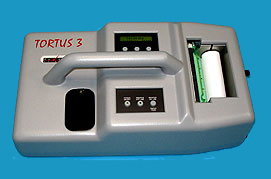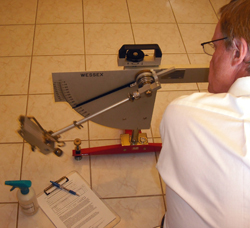Reliable Slip Resistance Test Methods
The pendulum DCOF tester, SlipAlert, and Tortus III slip test instruments all have official slip resistance test standards based on actual slip and fall research done with them, and are therefore far more reliable methods of testing floor and tile slip resistance than the ANSI A326.3 floor slip test. Safety Direct America can perform the ANSI A326.3 tile slip test, but does not recommend it for assessing safety. Here’s more information on how you can have a slip resistance test (DCOF rating) on your flooring or tile using reliable, highly-researched slip test instruments.
The pendulum is the slip tester used by at least 50 nations and it has been endorsed by the Ceramic Tile Institute of America since 2001. Australia, Germany and the United Kingdom have been using this instrument to assess slip and fall risk for several decades now, which makes it the most researched slip resistance test instrument on the planet.
Australia recently published the most sophisticated slip test standard in the world – HB198:2014 – which sets dynamic coefficient of friction (DCOF) guidelines for dozens of different floor situations. It makes sense that an outdoor pool deck might require more slip resistance than a tenth floor elevator lobby, and this test standard differentiates between those situations with different values of required DCOF. Here’s more information on pendulum slip testing in the USA. In 2022, ASTM E303-22 was published, which is an American pendulum test that now is very close to the test method used in Australia, across Europe, and the rest of the world. Safety Direct America is the expert in pendulum slip resistance testing in the Americas. Here are the ASTM E303-22 slip resistance test safety criteria for different areas in and out of a building that can now reliably be used with the ASTM E303-22 slip resistance test results to assess real-world floor safety. The pendulum DCOF tester is easily the most widely-accepted floor friction test device in the world today for lab and field testing of floors. ASTM E303 also describes a test method for assessing the skid resistance of roads, as well.

SlipAlert Tribometer
Maintenance issues such as soap residue build-up, and wear issues in high traffic areas can be quickly ascertained by the use of some on-site floor slip resistance testers, such as the SlipAlert (now known as the iAlert Tribometer). The SlipAlert is for on-site slip testing only because it requires a long oath length to measure the floor’s slip potential properly, but with an official UK standard and lots of real-world research behind it, it is a tool that provides a great deal of information about slip risk in a short amount of time with very little training. It also has been shown to have great correlation with pendulum slip resistance test results.

BOT-3000E Tribometer
The BOT-3000E, used in the ANSI A326.3 (and the older ANSI A137.1) slip test method, can be used to compare surfaces, but the test method states it should not be used in assessing safety. The latest test method promoted by the TCNA (who works for tile manufacturers and floor polishers, not architects or people concerned with safety) states that “The coefficient of friction (COF) measurement provided in this standard is an evaluation of hard surface flooring materials under known conditions using a standardized sensor material prepared according to a specific protocol. As such it can provide a useful comparison of surfaces, but does not predict the likelihood a person will or will not slip on a hard surface flooring material.”
But slip testing using the A326.3 test method can still be done by Safety Direct America here in the USA. Why would you want to run that test method? Because you may need a certified report for your records showing that your flooring has passed this minimum requirement. This test was created by the same people who promoted ASTM C1028 for many years, which is now withdrawn and considered worthless in assessing a floor’s safety.

Tortus Tribometer
The Tortus 3 (above) and SlipAlert (or iAlert Floor Tribometer) are also reliable slip test instruments that have current slip test standards in Australia and the United Kingdom, respectively. These instruments can be invaluable since they run tests very quickly on site and can tell a building owner or manager if there are significant differences in slip resistance over various spaces.
Slip resistance test standards in the USA have historically given “passing grades” to almost all types of flooring – slippery when wet or not. Now, thanks to well-researched instruments from Australia, the United Kingdom and Germany, your real-world slip risk can be competently evaluated so that you choose the proper flooring for each particular situation. For reliable slip testing in the USA, visit SafetyDirectAmerica.com/Floor-Friction-Testing. They also offer remedial solutions for all types of floors and situations, such as anti-slip tape, do-it-yourself non-skid floor coatings, and non-slip floor treatments.
Get reliable, certified, professionally stamped floor slip resistance testing done at Safety Direct America.

